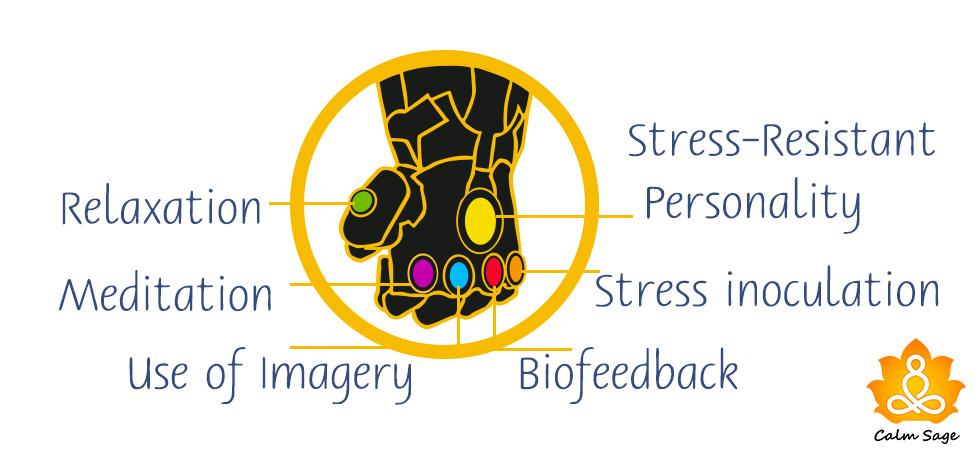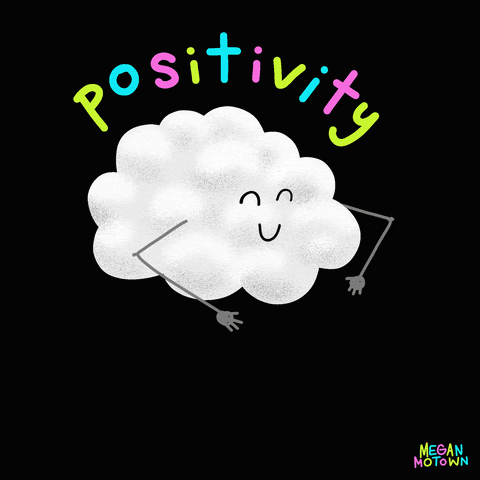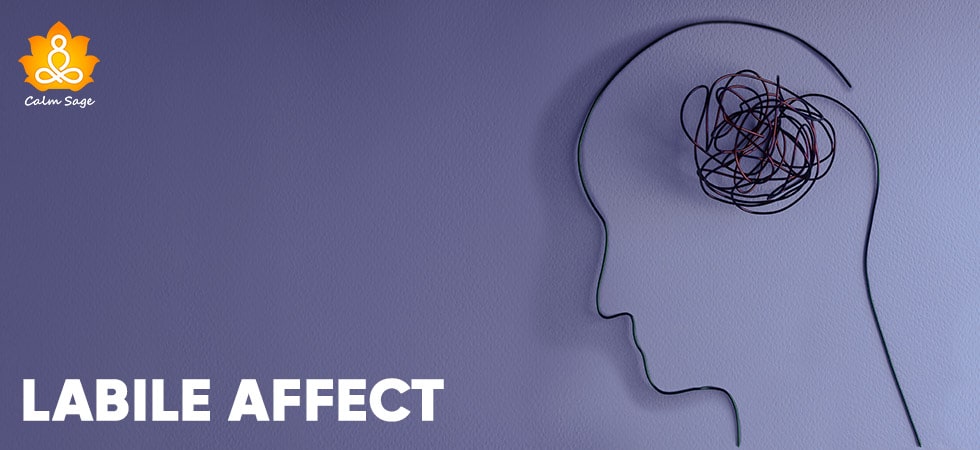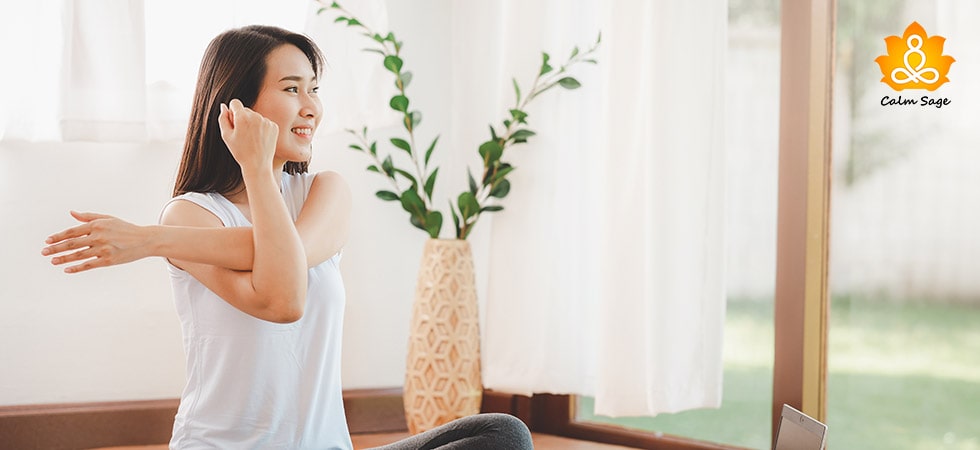6 Effective Stress Management Techniques | Vanish Your Stress at a Snap

We all do experience stress in our lives in one way or the other! Sometimes the source of stress comes from outside like- meeting a deadline or taking an exam. Other times we tend to experience stress due to internal sources, such as self-doubts, mood swings, to name a few. Irrespective of the source of stress, we all strive to manage it and lower the level of stress that we are currently experiencing in our lives.
Well, what if I tell you that you can say good-bye to stress at a snap of your fingers!
No kidding! I am serious!
Have you heard of Thanos? The giant guy from the Avengers who had 6 magical stones with him that gave him the ultimate power to end half of the world at a snap!
I am going to hand over his stone embedded glove to you which will give you the power to break ties with stress. Sounds interesting, doesn’t it?
So here is your glove for stress management technique!

Now it is time to explore each of these stones and see the power they have and you need to manage your stress.
Effective Stress Management Techniques:
1. First Stone: Relaxation
The first stone of our glove or stress management technique is Relaxation. There are various ways to relax yourself however the one that is proven to work the best is-
Deep breathing along with muscle relaxation. All you have to do is lie down, start deep breathing, focus on each part of your body, starting from the toes. Now, progress upwards while relaxing each part of your body and deep breathing simultaneously. End this relaxation process once you reach the upper part of your head. It will calm your mind and body, from tip to toe.
Writer’s Tip: You can also opt for mindful breathing exercises, wherein you inhale and exhale in particular patterns or with specific counts. You can print it out, paste it in your study area or workspace and practice it every time stress swipes in.
2. Second stone: Meditation
The stress management technique ‘Meditation’ is a subtle art of bringing your consciousness into the current moment. There are various forms of meditation, mindfulness meditation, chocolate meditation, dynamic meditation, etc. You can practice any form of meditation that approaches you the most. If you face difficulty starting it, then you can begin by applying mindfulness in basic life tasks. From walking mindfully to eating mindfully, you will be meditating.
If you are tech-savvy you can also use gadgets like Museband that will help you with stress management.
Writer’s Trip: If you are tech-savvy you can also use gadgets like Museband that will help you with stress management.
3. Third stone: Use of Imagery
Imageries have been found to work amazingly well in reducing stress levels. It is a form of creative visualization that brings our bodily sensations down to equilibrium, which otherwise increases under stressful situations. You can apply this stress management technique by following these steps:
- Set a goal (example- get my pulse rate in control)
- Find a quiet and comfortable place
- Close your eyes
- Now, visualize imagery that can reduce your stress (example- a beach)
- Apply these steps every time you face a stressful situation. Don’t know where to begin?
Here is a calming slideshow of calming images and music that you can see before going to bed and calm yourself down.
Writer’s Tip: Here is a calming slideshow of calming images and music that you can see before going to bed and calm yourself down.
4. Fourth stone: Biofeedback
There are various physiological signs associated with stress. Ranging from increased heart rate to palpitation. Reducing or controlling the level of these bodily signs of stress is yet another important stress management technique that can work for you. Biofeedback works as a procedure that monitors and reduces the physiological aspects of stress by providing feedback about current physiological activities. This process starts first at a very personal level and then you can execute it to your day to day life. Here is a step-by-step guide for you to imply it in your lives:
- Start by becoming aware of your bodily responses
- Next, learn ways to control it first in quiet conditions (through deep breathing, massages, or gadgets)
- Finally, execute it in your daily lives
Shiatsu Hand Massage Technique is found to be an effective way to manage stress and anxiety. It will help you reduce your level of physiological activities and get a better hold of the same.
Writer’s Tip: Shiatsu Hand Massage Technique is found to be an effective way to manage stress and anxiety. It will help you reduce your level of physiological activities and get a better hold of the same.
5. Fifth stone: Stress Inoculation Training
The term Stress Inoculation training comes from cognitive-behavioral techniques. The word itself might sound difficult but it is quite simple and easy to practice. The primary focus here is to replace negative thoughts with positive ones. Sounds easy right? But now the question comes… How? Follow these three steps:
- Assess your stress level. You can take our stress-o-meter test to find your stress level
- Apply stress reduction techniques that are mentioned above
- Follow through.
- Check your level of stress post applying stress management techniques that we just discussed.
Writer’s Tip: Remember each individual and their source of stress is unique. To resolve the same you have to try different combinations of stress-management techniques. You never know which one works best for you! So, keep trying till you regain your calm.
6. Sixth stone: Stress-Resistant Personality
Probably the most powerful and ultimate stone! Wondering, why?
Well, this “stone” can help you develop the personality traits of hardiness i.e., Commitment, Control, and Challenge. This will help you deal with the highest level of stress without hampering your mental or physical health.
Now how to develop these personality traits? The answer is, by building a stress-resistant personality.
Recent studies by Kobasa have shown that people with high levels of stress but low levels of illness share three characteristics, which are referred to like the personality traits of hardiness. It consists of ‘the three Cs’, i.e. commitment, control, and challenge.
Everyone does not have these characteristics, many of us have to relearn specific life skills in areas such as rational thinking, and assertiveness to equip ourselves better to cope with the demands of everyday life, etc.
So to get a hold of this 6th stone by learning the 5 life-skills that are at the heart of it.
All you have to do is take A T.R.I.P! Where,
A Stands for Assertiveness:
Assertiveness is a behavior or skill that helps to communicate, clearly and confidently, your feelings, needs, wants, and thoughts. It is the ability to say no to a request, to state an opinion without being self-conscious, or to express emotions such as love, anger, etc. openly. If you are assertive, you feel confident and have high self-esteem and a solid sense of your own identity.
T stands for Time Management:
The way you spend your time determines the quality of your life. True, that! If you have taken the stress test i.e., stress-o-meter available on our page you might have noticed that many questions were framed around time. Reason- learning how to plan time and delegate can help to relieve the pressure. The major way to reduce time stress is to change one’s perception of time. The central principle of time management is to spend your time doing the things that you value, or that help you to achieve your goals. It depends on being realistic about what you know and that you must do it within a certain period, knowing what you want to do, and organizing your life to achieve a balance between the two.
R stands for Rational Thinking:
Many stress-related problems occur as a result of distorted thinking. The way you think and the way you feel are closely connected. When we are stressed, we have an inbuilt selective bias to attend to negative thoughts and images from the past, which affect our perception of the present and the future. Some of the principles of rational thinking are:
- challenging your distorted thinking and irrational beliefs,
- driving out potentially intrusive negative anxiety-provoking thoughts, and
- making positive statements.
I stands for Improving Relationships:
The key to a sound lasting relationship is communication. You can have healthy communication and perhaps a healthy relationship by practicing these essential skills:
- listening to what the other person is saying,
- expressing how you feel and what you think, and
- accepting the other person’s opinions and feelings, even if they are different from your own.
- It also requires us to avoid misplaced jealousy and sulking behavior.
P stands for Building Positive Attitude & Positive Thinking:
A positive life is a stress-free life. Some of the factors leading to a positive attitude are:
- having a fairly accurate perception of reality;
- a sense of purpose in life and responsibility;
- acceptance and tolerance for different viewpoints of others;
- taking credit for success and accepting blame for failure; and
- Being open to new ideas and having a sense of humor with the ability to laugh at oneself helps us to remain centered, and see things in a proper perspective.
Positive Thinking: The power of positive thinking has been increasingly recognized in reducing and coping with stress. Optimism, which is the inclination to expect favorable life outcomes, has been linked to psychological and physical wellbeing. People differ in the manner in which they cope. For example, optimists tend to assume that adversity can be handled successfully whereas pessimists anticipate disasters. Pessimists ignore the problem or source of stress and use strategies such as giving up the goal with which stress is interfering or denying that stress exists.

So, these were the five ways to apply the most effective stress management technique and build the most 3 C’s in your life. All you have to do is take A TRIP
A- Assertiveness, T- Time Management, R- Rational Thinking, I- Improve Relationship, P- Positive attitude and thinking.
Now that you have a hold of this six power stones glove! Time to snap and get a stress free life!
You can find a descriptive video on these 6 magic stones or stress management technique, to a stress-free life here:
I would request you all to implement at least 1 of these stress management techniques in your life for a week as of now and let us know how well it worked for you in the comment section below.




















